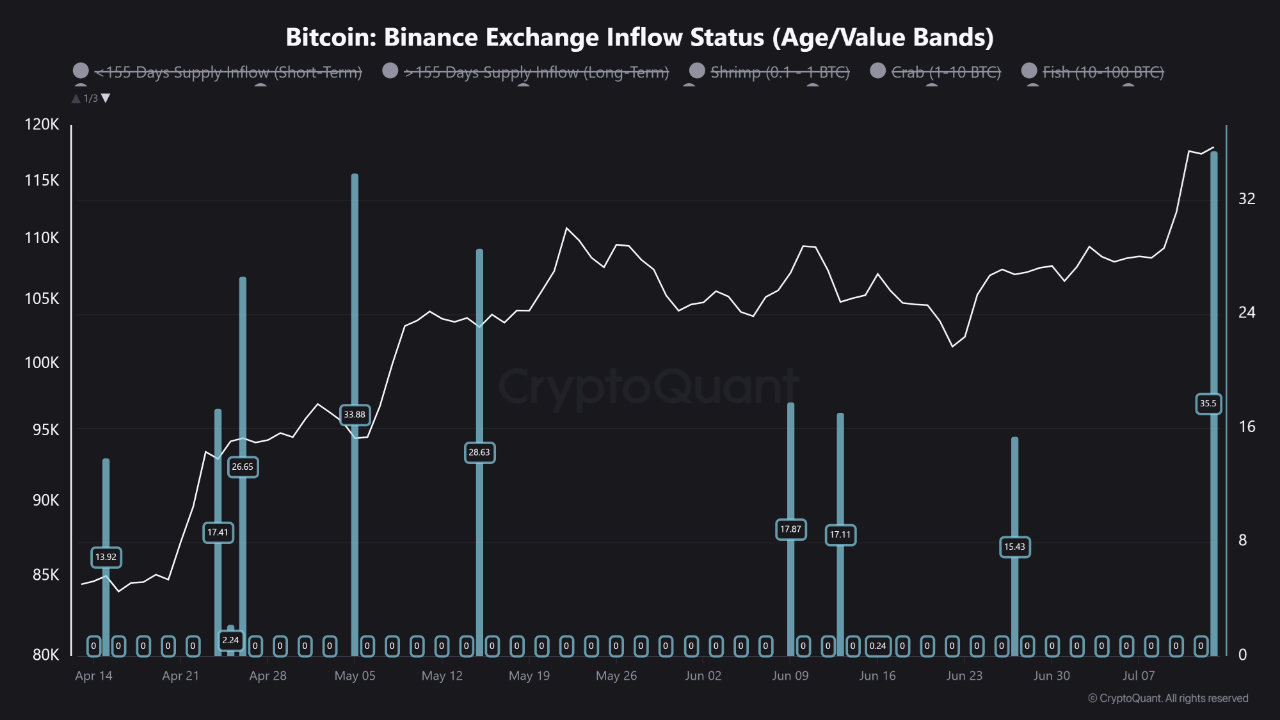-
A Satoshi-era whale has moved 16,843 BTC worth nearly $2 billion after 14 years, igniting concerns over a potential major Bitcoin market sell-off.
-
Bitcoin’s “Coin Days Destroyed” metric surged sharply, historically a reliable indicator of impending price corrections following extended rallies.
-
Whale activity on Binance has intensified, with transactions exceeding $1 million accounting for 35% of Bitcoin inflows, signaling possible profit-taking or strategic repositioning.
Bitcoin whale movements and Binance whale inflows raise red flags for potential market corrections amid Bitcoin’s new all-time high surge.
Satoshi-Era Whale Cashing Out as Bitcoin Peaks?
In July 2025, a significant event unfolded as a Bitcoin whale, holding over 80,000 BTC accumulated during the Satoshi era, initiated large-scale transfers after 14 years of dormancy. On July 15, Lookonchain revealed two major transactions totaling 16,843 BTC—valued at approximately $1.99 billion—moved to Galaxy Digital, a prominent OTC trading firm.
Subsequent transfers saw 2,000 BTC redirected from Galaxy Digital to centralized exchanges Bybit and Binance, triggering market apprehension. This movement coincided with a Bitcoin price correction exceeding 5%, pulling back from an all-time high of $123,100 to $116,900.
Spot On Chain remarked, “This is his first cash-out in 14.3 years,” underscoring the rarity and potential market impact of this whale’s activity.
The spike in Bitcoin’s Coin Days Destroyed metric following these transfers is particularly noteworthy. This metric measures the movement of long-dormant coins and has historically served as a predictive signal for market corrections after sustained price increases, reinforcing concerns about near-term volatility.
Binance Whale Activity Spikes as Bitcoin Reaches ATH
Parallel to the whale’s movements, CryptoQuant data analyzed by analyst Crazzyblockk highlights a surge in whale transactions on Binance. Transactions exceeding $1 million now constitute over 35% of Bitcoin inflows to the exchange, a significant increase compared to previous periods.

Binance Exchange Inflow Status. Source: CryptoQuant.
Crazzyblockk’s analysis points to the age of coins being deposited, revealing that many originate from older wallets. This suggests two plausible market dynamics at play:
- Profit-Taking: Long-term holders capitalizing on Bitcoin’s historic price surge to secure gains.
- Speculation: Investors leveraging Binance’s liquidity to hedge positions or open new trades amid heightened volatility.
He concluded, “The presence of this much ‘sell-side’ pressure on the market’s primary trading venue increases the risk of sharp price swings.” This dynamic underscores the delicate balance between profit realization and strategic positioning among large investors.
Market Implications of Whale Movements and Exchange Inflows
The convergence of dormant whale activity and increased large-scale inflows to Binance paints a complex picture for Bitcoin’s immediate future. While legacy holders appear poised to monetize gains accumulated over more than a decade, institutional and publicly listed entities continue aggressive accumulation strategies, intensifying market competition.
This tug-of-war scenario introduces heightened uncertainty, with potential for increased volatility as market participants react to whale movements and exchange liquidity shifts. Traders and investors should monitor on-chain metrics and exchange inflow patterns closely to anticipate possible price fluctuations.
Conclusion
The recent activity of a Satoshi-era whale moving nearly $2 billion worth of Bitcoin after 14 years, coupled with surging whale inflows on Binance, signals a critical juncture for the Bitcoin market. While these movements may indicate profit-taking by long-term holders, they also reflect strategic positioning amid Bitcoin’s record-breaking price levels. Market participants should remain vigilant, as these developments could precipitate significant price volatility in the near term.







